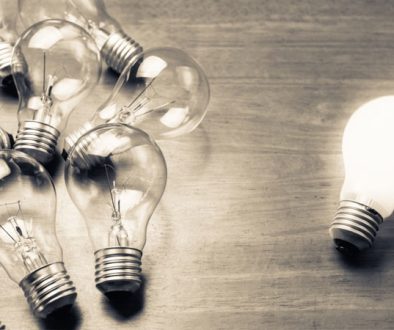What you NEED to Know about Thyroid Hormone
I frequently use the “factory analogy” to describe health. In case you aren’t familiar with it, here it is: Your body runs on electricity and chemistry. In chemistry there is a starting product→chemical reaction→different product. This is like a factory, where there are raw materials→factory workers assembling→finished product.

Here’s a key point–thyroid hormone is what turns on the lights and makes the conveyor belts run in your intracellular factory! Thyroid hormone stimulates energy production. And without energy? Nothing happens. Zippo, nada, nil. Thyroid hormone is important!
The traditional medicine algorithm for monitoring thyroid hormone is a test called “TSH with reflex to T4”. This test checks thyroid stimulating hormone (TSH), and if it is out of range the lab will automatically check a Free T4 (thyroxine) level. If it is within range, no other testing is done. You are told “Your thyroid is normal”.
But what if you don’t FEEL normal? What if you are tired, foggy, struggle with your weight, constipated, losing your hair? These are ALL very common symptoms of underactive thyroid, or hypothyroidism. What if you have these symptoms but your doctor tells you that you aren’t hypothyroid because your TSH is normal? Next step in this scenario is often “eat less and exercise more” or “it’s normal at your age to feel tired” or “here’s an antidepressant”… Ugh.
As a gynecologist, I heard this cry for help from SO many women “I KNOW something is wrong because I feel like sh*t but my doctor tells me my labs are normal!”
TSH is NOT the right test
Here’s the thing. I don’t believe TSH is the best test for monitoring thyroid health. Let me tell you THREE key reasons why:
1. TSH is NOT thyroid hormone!
TSH is made in the brain. The brain is the supervisor of the factory. It is looking down from above… Is everything going ok? Everybody happy? Workers getting their jobs done? If the brain senses that things are sluggish, that the factory’s lights are dim or the conveyor belts are too slow then it sends a signal to the thyroid to make more thyroid hormone. So TSH is just a signaling hormone, NOT thyroid hormone.
Another way to look at it… Let’s say that you are a parent (the brain) in charge of little Johnny (the rest of the body), and he needs to get up and get ready for school or he’s gonna miss the bus. TSH is how loud you have to knock on Johnny’s door in the morning. If he’s responsive, you don’t have to knock very loudly “I’m up and will be down soon!”… If he’s a slug then you have to bang on the door to get him out of bed. But what if YOU’RE in bed not feeling well? What if you aren’t supervising? What if you think Johnny is fine and he’s really asleep? You will not knock on the door and Johnny will miss the bus!
The above analogy happens in situations like severe stress, stealth infections and overwhelming environmental toxicity. The control center of the brain (the hypothalamus) gets knocked out and loses its ability to appropriately supervise. In these cases I’ve seen low thyroid hormone AND low TSH. But if I hadn’t checked all the hormones at once, if I’d only checked “TSH with reflex to T4” I would have totally missed it.
2. The normal range used for TSH is too broad.
While the normal range for TSH varies among laboratories, somewhere in the neighborhood is 0.45-4.5.1 That’s a 10-fold difference between lower and upper-end of normal range! Why is this? I honestly don’t know. Maybe it has to do with the fact that “normal range” is set to include 90% of the population.
Read that again–Lab companies (not doctors) set normal range specifically to include 90% of the population! The assumption is made that 9 out of 10 people are “normal”. Then using the statistical “normal curve” (remember the bell curve from highschool statistics?) they plot out the values in their lab and set a normal range to include 90% of the values.2
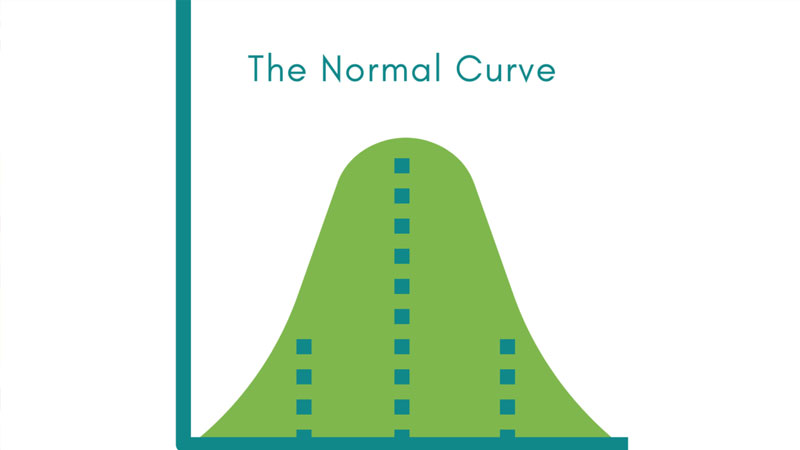
Wherever 5% is BELOW that point becomes the lower level of normal. Wherever 5% is ABOVE that point, that becomes the upper limit of normal. So with 5% on each end, that leaves 90% in the middle, and THAT is what “normal range” is!
Maybe SO MANY people have thyroid problems that the range is ALL OVER the place, and in order to capture 90% it has to be that big. What I DO know is that a factor of 10 is pretty big.
At Vitality Renewal, we want you to be at your BEST. We want you to feel GREAT, with plenty of energy and mental focus to get through your whole day. We want you to THRIVE. Do you honestly think that 9 out of 10 people are thriving? I don’t. That is why there’s a big difference between OPTIMUM and NORMAL RANGE!
3. Even if the test moves on to “reflex T4” things can get missed.
This is because T4 (thyroxine) is not the active hormone! While the hormone the thyroid gland secretes is 90% T4, T4 is a “pre-hormone”. In order to stimulate energy production the body must convert T4 (thyroxine) to T3 (triiodothyronine).
T4 consists of a tyrosine amino acid with 4 iodine molecules attached. T3 is the same tyrosine with 3 iodine molecules attached. The hormone receptor is for T3, not T4. The conversion to active hormone involves removing an iodine from T4.
Do you find it a little weird that T3 is the active hormone, yet that’s not what is checked even when the TSH is abnormal? I know I do!
Thyroid testing you NEED to get
OK so if TSH is not the best test, what is? Well it’s not just one test. We run a thorough thyroid panel that includes (in order of importance in my opinion):
- Free T3
- Reverse T3
- Thyroid antibodies
- Free T4
- TSH
Wow–did you notice that the most commonly-run test (TSH) ranks at the BOTTOM of the list of importance? Permit me to explain why I rank them that way.
Free T3 is the hormone that triggers the receptor on the membrane, triggering the energy production. THAT’S important.
Reverse T3 (RT3) gets a little complicated. RT3 is a stereoisomer of T3. Huh? This means it has the same ingredients, but a different shape. Since it has a different shape it doesn’t stimulate the receptor. So it’s a dud.
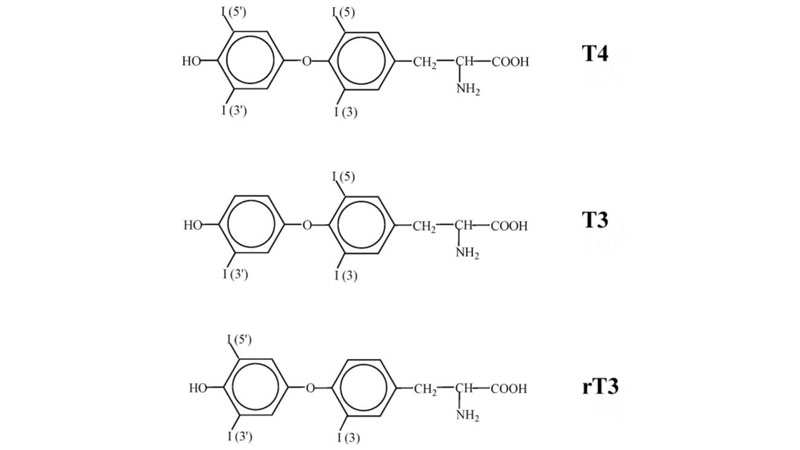
The picture above shows the different shapes of T3 and RT3. OK… if it’s a little too “sciency”, here’s a simple explanation:
Why would your body do that–make an inactive hormone? It’s a stress/protection response. It probably goes back to the origins of man, where the main stressor was lack of food. In times of famine you don’t want to be burning through energy. So the body would make RT3 as a protection, sort of a forced hypothyroidism, a biochemical hibernation, until food was in good supply again.
The problem is that with our modern life, MANY things lead to this abnormal thyroid hormone metabolism of too much RT3.
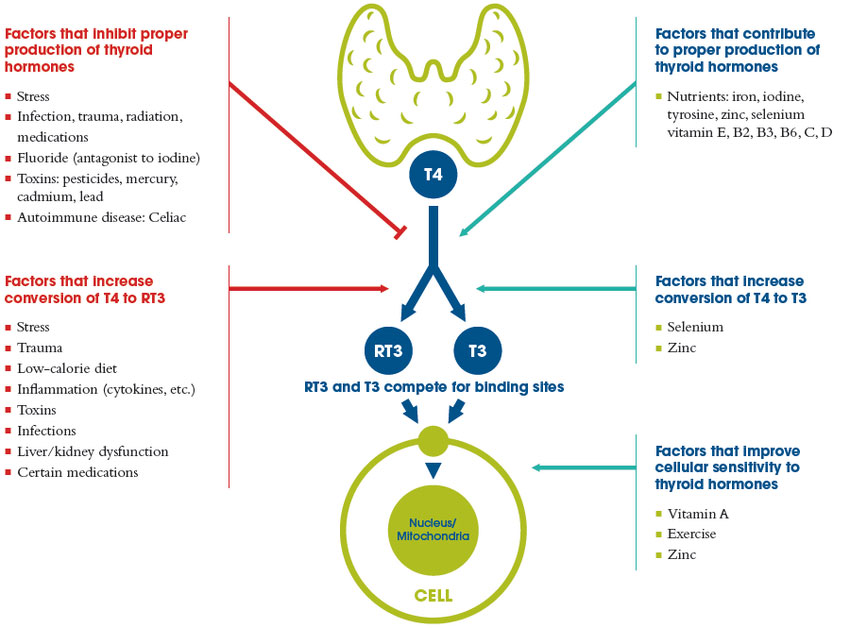
(graph courtesy of the Institute for Functional Medicine)
Gee… Notice that selenium and zinc are needed to make T3? Elevated RT3 can come from inability to make T3 (not enough selenium and zinc) or something pulling you down the RT3 pathway– like STRESS! And Toxins! The list is pretty significant!
In my practice, we see high RT3 a lot. In these cases the client totally feels hypothyroid, but the commonly-checked labs are normal. The ultimate treatment in this case is not thyroid hormone, but to fix the abnormal thyroid-hormone metabolism!
Thyroid antibodies:
These include thyroid peroxidase antibodies (TPO) and thyroglobulin antibodies (TGA), and are listed #3 because if you have them you have a very confused immune system. It’s a big red flag! This is called Hashimoto’s Thyroiditis. It’s a form of autoimmunity. Your immune system has built antibodies against components of your thyroid gland. Over time this attack can lead to hypothyroidism, as your thyroid gland gets destroyed and can’t make enough hormone.
It’s also a red flag because if your immune system is attacking your thyroid gland today, what’s to prevent it from attacking other body parts tomorrow?
Free T4
Free T4 IS important, as it’s what the thyroid gland produces, but it’s just not as important as the other three markers. It has to be converted to the active hormone…
TSH
Yep. I truly think TSH ranks last in importance. It’s not thyroid hormone. It’s a measure of how well the brain is supervising the rest of the body. We’ve already talked about this issue, and what can knock out the control center. I check it, but I don’t check it ALONE. And yet, that’s all your doctor is told to check by the traditional-medicine algorithm.
Testing without a needle–Basal Body Temperature (BBT)
Since thyroid hormone is important for metabolism, checking your basal body temperature is a great non-invasive test to give you an idea of your thyroid-hormone status. Here’s how:
- Check your first morning temperature (before getting out of bed)
- It should ideally be 98.8-99.2 F under the tongue or 97.8-98.2 F axillary (armpit)
- Check several days in a row to get your average. If you are still menstruating, check it while you are on your period, if not you can check any time of the month
Consistent values less than 97.8 F (oral) or 97.3 F (axillary) suggest low thyroid.3
It is important for you to know that using BBT to assess thyroid function is controversial. That doesn’t bother me, because a lot of things are controversial! The American Thyroid Association does not recommend this.4 When we can’t prove something with certainty, I ask myself if it makes physiologic sense, based on what I know about how the body works. The answer, for me, with BBT and thyroid hormone optimization is “yes”.
Let’s go through the logic. We know that thyroid hormone is a primary mediator of our metabolic rate.5 We know that our basal metabolic rate is related to thermogenesis (heat creation).6 Does it make physiologic sense that our core temperature, then, would be an indicator of how well our thyroid hormone is functioning? I think yes. Notice I didn’t say what your thyroid hormones are, but rather how well your hormones are functioning. I’ll discuss that a little later…
How to get the RIGHT tests
In order to get the appropriate testing done you have a few options. Obviously you can work with a knowledgeable practitioner who appreciates the importance of testing ALL the hormones. You can also try your luck with your primary care provider by taking a wish-list that has the above tests. Here’s a link to a handout I made that summarizes the thyroid tests you should have done. It also gives you information on how to get them done on yourself, in case your provider won’t order the right tests.
Natural support for thyroid
If your thyroid hormone is not optimized, a great starting point is to SUPPORT the proper thyroid gland function and thyroid hormone metabolism/activation. Here are some tips.
Tyrosine
Tyrosine is the amino acid base for thyroid hormone. The Recommended Dietary Intake (RDI*) for tyrosine is based on weight. For a 150 pound adult the recommendation is 980 mg7. Foods rich in tyrosine include:8
- Beef (2174 mg in 6 ounces)
- Pork (2088 mg in 6 ounces)
- Salmon (2052 mg in 6 ounces)
- Chicken breast (1964 mg in 6 ounces)
- Turkey breast (1365 mg in 6 ounces)
- White beans (490 mg per cup)
- Pumpkin seeds (306 mg per ounce)
Iodine
Iodine is the crucial ingredient that distinguishes T4, T3 and RT3. T4 has 4 iodine molecules, T3 has 3 iodine molecules, and RT3 has 3 iodine molecules in a different location from T3.
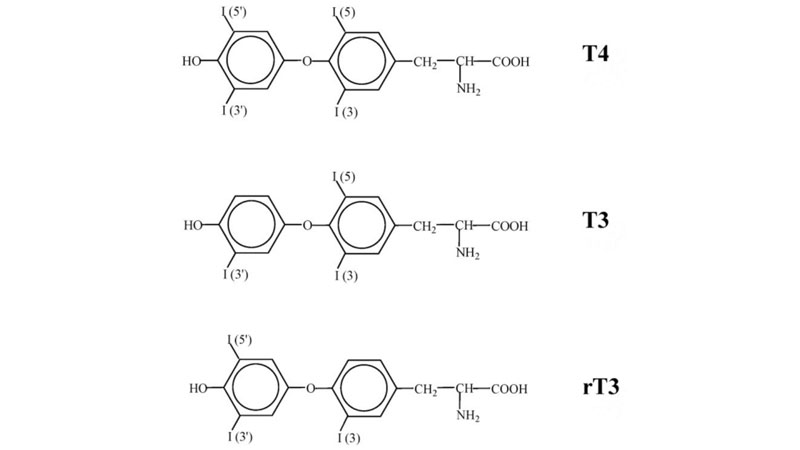
The recommended daily allowance (RDA) for iodine is 150 mcg.9 I have to tell you this is hotly debated in functional medicine circles! MANY experts think it should be higher, as iodine is not only beneficial for thyroid function, but protective against breast cancer! But I digress… Let’s stick to thyroid function and food sources of iodine! Other than fortified foods (table salt and enriched flour) iodine is found in seaweed, seafood (especially white fish) dairy products, and liver.
Selenium
Selenium is very important for T3 production. Deficiencies in this mineral also increase risk for Hashimoto’s Thyroiditis.10 The recommended daily intake for selenium is 55 mcg for non-pregnant women.
By far, the food richest in selenium is Brazil nuts.11 Just 3 Brazil nuts contain 272 mcg selenium! Other sources include:
- Sea food
- Beef
- Turkey
A GREAT thyroid support supplement:
Renew Thyroid contains a blend of iodine, natural iodine sources, selenium, bovine thyroid gland and adrenal support herbs to give comprehensive thyroid support.
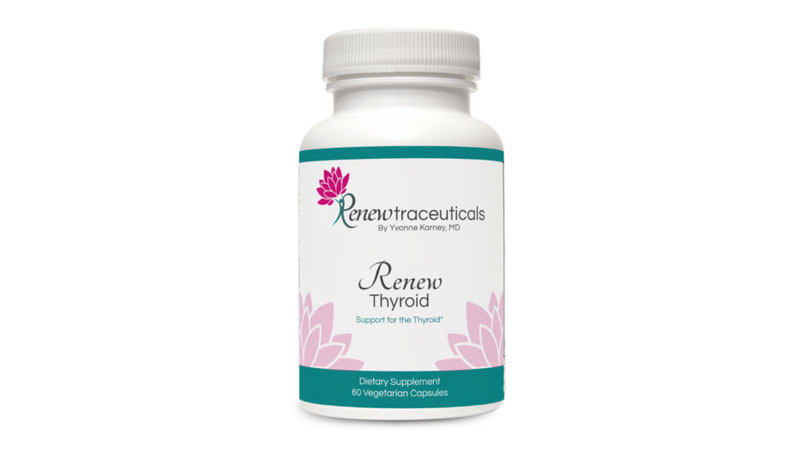
Zinc
Zinc is important for converting T4 to T3. At Vitality Renewal, we check zinc levels to make sure they are optimum. The ideal range for serum zinc is 100-115 mcg/ml, even though “normal range” is much more broad– 44-115 mcg/ml, according to our local LabCorp.
Zinc can be found in the following foods:12
- Meat
- Shellfish
- Legumes
- Nuts & seeds
- Eggs
While most of my patients actually do require a zinc supplement to reach optimum levels, I recommend testing prior to starting zinc.
Stress reduction
The adrenal glands and your thyroid are intimately connected. Persistent high stress strains the adrenal glands, and leads to abnormal thyroid hormone metabolism down the RT3 pathway. Another issue is that high stress triggers the control center that regulates your heart rate (the SA node). If you combine an uncontrolled stress-response with thyroid medication you might just get heart palpitations. This is uncomfortable. It makes you feel like you are too revved up, like you’re on too much medication. In short, it makes you intolerant to the thyroid medication, even if you need it. The bottom line is you can’t out-supplement or out-medicate a shitty lifestyle.
That’s why stress reduction is ALWAYS part of what we work on in my RENEW Method™ Programs.
Detoxification
Toxins lead to inflammation and this causes abnormal thyroid hormone metabolism down the RT3 pathway. They also make your hormones not work well (I’ll talk more about this in a little bit…) We take a deep dive into this in my RENEW Method™ Programs.
You have to be careful with detoxification, because if you have a lot of stored toxins you can get really sick by mobilizing them too fast. What you CAN do safely is reduce the toxins you bring into your body–I never met anyone who got ill doing this!. I created a handout on this, which I’m happy to share with you here.
What about thyroid medication?
OK so let’s say you’ve been diagnosed with hypothyroidism, tried the above support, and your levels are still not quite right. Your doctor will likely give you a prescription for thyroid hormone. So let’s talk about that next… Options for thyroid medication occur in three broad categories:
- Levothyroxine
- Liothyronine
- Natural desiccated thyroid
Levothyroxine
The most commonly prescribed medication is Levothyroxine. It was discovered in the early 1900’s and since 1970 it has dominated medical recommendations. The brand name of this is Synthroid. This hormone is T4, and requires the conversion to T3 to be intact. If your hormone metabolism is healthy then it’s great! Your body will convert the T4 to Free T3 and everybody is happy.
But what if you don’t convert well, as we discussed above? In that case you may have great T4 levels, but you will still feel hypothyroid, because convert the T4 to RT3. And when you confide in your doctor that you don’t feel well, you will get all those hideous answers:
“Your labs are normal; It’s normal for your age; Maybe you’re depressed…” Medical gaslighting.
Liothyronine
Liothyronine is T3, the active hormone. It has been around since the 1950’s. A study revealed that women felt better and had a higher morning temperature on Liothyronine compared to Levothyroxine.13 A downside of the medication is that it requires taking it multiple times a day (2-3) due to its short half-life. In my experience, it also causes heart palpitations in a significant proportion of takers.
Natural desiccated thyroid
This comes from pork thyroid. Available forms are Armour Thyroid and NP Thyroid. Previously available was NatureThroid, but it’s been gone for a while. For simplicity I’m going to use the term NP to discuss desiccated thyroid.
Prior to the discovery of how to make Levothyroxine in the 1940s, desiccated thyroid was all we had.14 An advantage of NP is that it has both T4 and T3 in it. The ratio is fixed roughly at 80% T4 and 20% T3. A lot of people do really well with desiccated thyroid! There HAVE been some issues with quality-control, because it comes from a natural source instead of a lab. The dosing is by mg of pork thyroid, and the amount of hormone in this weight can vary slightly amongst lot numbers. This really bothers a lot of professionals.
Despite the periodic issues with lot variations, I find NP a very useful and well-tolerated medication. At Vitality Renewal, we check labs more frequently than other practices, and also educate our patients about symptoms of too-much or too-little medication, so we are far less likely to have negative experiences with undiagnosed abnormal hormone levels due to lot variations.
Testing for thyroid dosing adequacy
This is an area that breaks my heart a little. Most people are tested for thyroid-hormone dosing adequacy once a year, and not given ANY guidance on WHEN to test. This is a big deal!
Here’s why… Your hormone levels will vary throughout the day as you absorb, use and metabolize the medication. If you test first thing in the morning, before you take your medication, your hormone levels will be the LOWEST of the day. I may see this level and tell you that you need more thyroid hormone. If you get your blood drawn about 2 hours after you take your medication, your levels will be the HIGHEST of the day, and I may think you’re on too high a dose. If you go at a different time for each blood draw your levels will look different, even though you’re on the same dose of medication. It’s like a moving target..
I ALWAYS check levels 6 hours after the morning dose. I often dose NP and ALWAYS dose Liothyronine at 12-hour intervals. So the 6-hours is right in the middle of the two doses. That will give me the mid-way point of hormone levels, and since we are consistent with this with EACH blood draw, it’s a stable point in time.
Of course, we also check the FULL thyroid panel and not just a TSH. We also use optimal level and not “normal range” as our goal. With these methods, we have excellent success in treating hypothyroidism.
Let’s NOT forget the thyroid hormone RECEPTOR!
One more thing–probably the most important. We need to have a healthy hormone receptor!
Hormones are messengers. Thyroid hormone only works when it attaches to the receptor to trigger the cascade that leads to energy production. This was what I was alluding to above when I used the phrase “how well your thyroid hormone functions”… Just having the right amount of hormones is not enough. You need it to be able to trigger its intended response.
It gets a little sciency here, but stick with me… Hormone receptors live on the cell membranes and the membranes are made of fat–phospholipids actually.
The phospholipids that make up the membranes have fatty acids in them that are delicate. Snowflake delicate. These are omega-3 and omega-6 fatty acids. These fats get damaged by inflammation from toxins in a process called “oxidation”. When this happens their structure changes. Picture saran wrap that is held over an open flame–that’s what your cell membranes look like when the phospholipids are oxidized by inflammation!
The hormone receptors are now covered in this melted plastic. So how on earth is the hormone supposed to be able to access the receptor to trigger its intended response? It can’t! This is what I call “hormone resistance”. And THIS is why I say–It takes MORE than hormones to fix your hormones!
In order to get ANY of your hormones working right–thyroid, insulin, estrogen, testosterone… we have to repair/rebuild the damaged cell membranes so that the receptors are healthy. Then your hormones will have a fighting chance!
How to repair the cell membrane (and hence hormone receptors)
This is something we take a deep dive into in my programs, using my RENEW Method™. A full discussion is beyond the scope of this post, or it would be a full-length book. The main thing for THIS current post is that you realize that it’s possible to heal.
Summing it up
Thyroid hormone is pretty damn important. Equally important is healthy hormone receptors so that the hormone can do its job! Traditional medicine does a lousy job at helping you optimize your thyroid hormone because it doesn’t look deep enough. Traditional medicine does a lousy job at helping you optimize your health, because it is disease-focused and not health focused!
Knowledge is POWER. I hope you will take this information and go do something with it! We are here for you if you need us. Follow this link to learn how we might work together.
*RDI is the daily intake recommended to meet the needs of 97% of healthy individuals.
References:
-
https://www.labcorp.com/tests/004259/thyroid-stimulating-hormone-tsh
- http://www.clinlabnavigator.com/reference-ranges.html
- https://careclinic.io/thyroid-temperature-chart/
- https://www.thyroid.org/american-thyroid-association-statement-on-wilsons-syndrome/
- https://pubmed.ncbi.nlm.nih.gov/9100583/
- https://www.ncbi.nlm.nih.gov/pmc/articles/PMC2744512/
- https://www.ncbi.nlm.nih.gov/books/NBK234922/#ddd0000066
- https://www.myfooddata.com/articles/high-tyrosine-foods.php
- https://ods.od.nih.gov/factsheets/Iodine-HealthProfessional/#h2
- Thyroid. 2006; 16:455-60
- https://ods.od.nih.gov/factsheets/Selenium-HealthProfessional/
- https://www.healthline.com/nutrition/best-foods-high-in-zinc#TOC_TITLE_HDR_9
- https://www.ncbi.nlm.nih.gov/pmc/articles/PMC8639573/
- https://www.ncbi.nlm.nih.gov/books/NBK585642/




